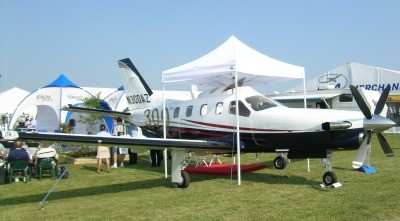TBM Owners "Off The Hook" For Expensive Fix... If Needed
 The documentation
supplied with a recent FAA Airworthiness Directive proposal is
rumored to have caused heart palpitations for some owners of
Socata's speedy TBM 700 turboprop.
The documentation
supplied with a recent FAA Airworthiness Directive proposal is
rumored to have caused heart palpitations for some owners of
Socata's speedy TBM 700 turboprop.
Despite Socata statements published last year, the FAA reported
that the cost of full compliance with the ADs and the replacement
of the TBM's gear (for those so affected) would set back owners as
much as $127,040... whereupon a number of TBM owners commenced to
start having serious heartburn (or worse).
The AD results from a mandatory service bulletin published by
EADS Socata in mid-2006 and EASA reports of landing gear cracks
amongst high-time operators of the aircraft.
Unfortunately; something got lost in the process of preparing
the FAA's proposed AD, since Socata had already published that, if
necessary, it would bear the five figure replacement cost for those
TBM 700s needing a 'new set of shoes.'
OK... a note to all TBM 700 owners -- take a deep breath, you're
not going to have to break into your piggy bank... this bill is on
Socata. Commence breathing again, now...
So... what happened here?
According to the summary supplied with proposed AD
2006-CE-65-AD, the FAA proposed "to adopt a new airworthiness
directive (AD) for (EADS SOCATA Model TBM 700 Airplanes). This
proposed AD results from mandatory continuing airworthiness
information (MCAI) issued by an aviation authority of another
country to identify and correct an unsafe condition on an aviation
product.
 The MCAI describes the unsafe
condition as cracks found on several main landing gear cylinders.
The proposed AD would require actions that are intended to address
the unsafe condition described in the MCAI."
The MCAI describes the unsafe
condition as cracks found on several main landing gear cylinders.
The proposed AD would require actions that are intended to address
the unsafe condition described in the MCAI."
In a letter to the TBM community, Raphaël Maitre, EADS
Socata, VP, Customer Service stated that, "The FAA has initiated a
Notice of Proposed Rule Making (NPRM: 2006-CE-65-AD) that prepares
a forthcoming Airworthiness Directive. This is the normal process
for the FAA when a mandatory Service Bulletin has been issued.
EADS Socata had earlier issued a mandatory Service Bulletin in
April 2006 about potential cracks on the landing gears (for high
cycles units only: see SB 70-130-32). Unfortunately; the FAA has
evaluated the cost of compliance of $125,600 per aircraft for the
parts only. The press has simply copied this information and
released it.
The reality is that the SB only calls for regular NDT inspection
and has a very small cost (a few hundred dollars during annuals
inspection). If any crack is found, EADS SOCATA has already
announced that the landing gears would be repaired at no cost to
the owner.
It seems the FAA has used new landing gears prices instead of
sticking to the real issue. We are communicating with them so that
they correct their text, of course."
ANN's discussions with Nicolas Chabbert, EADS Socata’s VP
Sales and Marketing, reinforced the laudable Socata commitment to
lower the impact of this proposed AD to TBM owners and operators...
indicating that the initial inspection (which is borne by the
owner) is often conducted in just a few minutes (using dye
penetrant) and costs but a few hundred dollars.
Eddy current alternatives (also an NDT inspection method) may
also be used to conduct the examination.
Chabbert, citing the "excellent working relationship" that
they've enjoyed with FAA, was at a loss as to explain why the FAA
failed to report the Socata offer to pay the costs of necessary
replacement. He added that they were "trying to find out now"
why such information didn't make it into FAA documents, and that he
had hopes that the FAA would update the documentation as soon as
possible.

The proposed AD had originally stated that, "Based on the
service information, we estimate that this proposed AD would affect
about 272 products of U.S. registry. We also estimate that it would
take about 18 work-hours per product to comply with the proposed
AD. The average labor rate is $80 per work-hour. Required parts
would cost about $125,600 per product. Where the service
information lists required parts costs that are covered under
warranty, we have assumed that there will be no charge for these
costs. As we do not control warranty coverage for affected parties,
some parties may incur costs higher than estimated here. Based on
these figures, we estimate the cost of the proposed AD on U.S.
operators to be $34,554,880, or $127,040 per product."

And... as previously noted, the Proposed AD never mentioned the
fact that Socata had promised to pay those costs earlier in the
year. More news to follow...
 Unfortunate... ANN/SportPlane Resource Guide Adds To Cautionary Advisories
Unfortunate... ANN/SportPlane Resource Guide Adds To Cautionary Advisories ANN FAQ: Turn On Post Notifications
ANN FAQ: Turn On Post Notifications ANN's Daily Aero-Term (04.29.24): Visual Approach Slope Indicator (VASI)
ANN's Daily Aero-Term (04.29.24): Visual Approach Slope Indicator (VASI) ANN's Daily Aero-Term (04.28.24): Airport Marking Aids
ANN's Daily Aero-Term (04.28.24): Airport Marking Aids ANN's Daily Aero-Linx (04.28.24)
ANN's Daily Aero-Linx (04.28.24)






